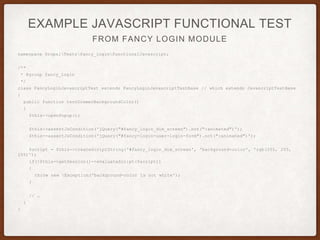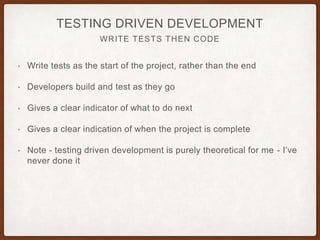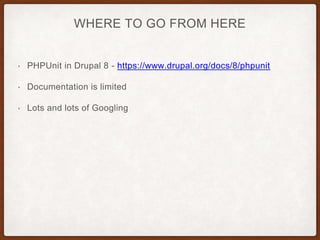Automated php unit testing in drupal 8
- 2. • @jaypan on Drupal.org and drupal.stackexchange.com • Acquia certified Drupal Grandmaster • Acquia Certified Developer • Acquia Certified Developer – Front end specialist • Acquia Certified Developer – Back end specialist • Living in Japan since 2000 • Working with Drupal since 2007 • Currently writing a book on coding in Drupal JAY FRIENDLY
- 3. JAY FRIENDLY • Owner of Jaypan in Yokohama • English https://www.jaypan.com • Japanese https://www.jaypan.jp • Jaypan specializes in • high-performance AJAX/JavaScript heavy applications • Custom module/theme development • App Development • Drupal integration with outside technologies • JavaScript libraries • Linux programs • Multiple Drupal instances • Technical consulting and translation (Japanese/English)
- 4. OVERVIEW • Manual testing vs. automated testing • How do automated tests work? • History of testing in Drupal • Types of automated tests in Drupal • Discussion of each type of test
- 5. MANUAL TESTING • Developer creates new functionality • Developer tests new functionality • Other people (client, team-members) test new functionality • Found bugs are fixed
- 6. PROBLEMS WITH MANUAL TESTING • Complex functionality requires significant time to test • Easy to forget to test a given scenario • Changes to code require re-testing every scenario after any change • Changes to code in other parts of the system may break functionality without anyone realizing it • As time passes, the conditions that need to be tested may be forgotten or lost as project members change • Coming back to code after a period of time means the developer is not sure what is required
- 7. AUTOMATED TESTING • Developer creates automated tests that run through all testing scenarios • Testing system runs all tests and reports any behaviors that are unexpected (aka bugs)
- 8. BENEFITS OF AUTOMATED TESTING • Removes requirement of getting humans to test after each code change • Tests are faster than human testing • Tests for the whole system can be run before committing any code to a production server, to ensure new functionality in one part of the system hasn’t broken functionality in another part of the system. • If (or rather, when) new bugs are found, tests can be added along with the fix, to ensure that the bug never arises again • Overall system is more stable.
- 9. PROBLEMS WITH AUTOMATED TESTING • Writing tests takes a significant amount of time • Extra time means extra development resources • Clients cannot directly see tests, and may not understand the extra costs in developing when there is nothing for them to look at. • Tests only test what they have been written to test. If the developer does not think to test something, a bug could exist. The existence of automated tests in such a case may create a false sense of security • Tests happen in a virtual (non-visible) environment, making them hard to debug (and even create) • Changing code often requires re-writing old tests
- 10. OR IN OTHER WORDS, WHAT IS IT? HOW DOES A TEST WORK? • A test will first run some code, then do ‘assertions’ to ensure that the results work as expected. • For example, in Drupal 8, nodes have a method id(), that returns the ID of the node. • An automated test would create a new node object, then run $node->id() and test: • Was a result returned? • Is the result an integer? • Is the returned ID the expected (correct) ID of the node that was created? • Any failed assertions result in a failed test, telling the developer exactly what failed, so they know what to fix.
- 11. AUTOMATED TESTING IN DRUPAL - HISTORY • Drupal 6 - Simpletest module • Drupal 7 - Simpletest in core • Drupal 8 - • Simpletest still in core but deprecated (to be removed in D9) • PHPUnit introduced into core • This presentation focuses exclusively on PHPUnit
- 12. TYPES OF TESTS IN DRUPAL 8 • Unit tests • Kernel tests • Functional tests • JavaScript functional tests
- 13. UNIT TESTS IN DRUPAL 8 • A Unit is a PHP Class (OOP) • Unit tests test code, not user-end functionality • Unit tests will test a single class, to ensure that it behaves as expected • Unit tests test the unit (class) alone in isolation, rather than in the Drupal environment • Unit testing is very fast, as the system does not need to be bootstrapped to run the tests
- 14. UNIT TEST OVERVIEW • Unit tests go in [MODULENAME]/tests/src/Unit • Namespace is DrupalTests[MODULENAME]Unit • Unit tests extend DrupalTestsUnitTestCase • Annotation should include (at a minimum) • Class: • @coversDefaultClass - the class the the test is testing • @group - the group of tests (usually module name) that the test belongs to • Method: • @covers - the method of the class being tested
- 15. UNIT TEST OVERVIEW • Testing class name should end in ‘Test’ • Example: the test for the Person class would be PersonTest • Testing method (function) name must start with ‘test’ • Example: the method used to test the id() method of Person would be testId()
- 16. UNIT TEST OVERVIEW • Test classes can have a setUp() method, that sets up conditions/objects before each test in the test class. • Useful when all tests require a similar set of conditions • Test classes can also have a tearDown() method, where objects are cleaned up after each test in the test class. • Test classes can have a setUpBeforeClass() method that is run once before the test class is run • Test classes can have a tearDownAfterClass() method that is run once after the test class is finished
- 17. CLASS (UNIT) TO BE TESTED class Person { private $id; public function setId($id) { $this->id = $id; } public function id() { return $this->id(); } }
- 18. EXAMPLE UNIT TEST FOR PERSON CLASS /** * @coversDefaultClass Person */ class PersonTest { /** * @covers ::setId() */ public testId() { $person = new Person(); $person->setId(123); $this->assertNotNull($person->getId(), ‘A value is returned for the ID’); $this->assertTrue(is_int($person->id()), ‘The returned ID is an integer’); $this->assertEqual(123, $this->getId(), ‘The returned ID is correct’); } }
- 19. KERNEL TESTS KERNEL TESTS IN DRUPAL 8 • Kernel tests are executed in a limited Drupal environment, similar to the environment before Drupal has been installed • Tests can access files and the database • Declared modules are loaded, but not installed. Installation needs to be done manually • Kernel tests are slower than Unit tests, but faster than Functional tests
- 20. KERNEL TEST OVERVIEW • Kernel tests go in [MODULENAME]/tests/src/Kernel • Namespace is DrupalTests[MODULENAME]Kernel • Kernel tests extend DrupalTestsKernelTestBast
- 21. EXAMPLE KERNEL TEST Sorry no example!
- 22. FUNCTIONAL TESTS IN DRUPAL 8 • Functional tests work in an installed Drupal environment • Modules needed for the test need to be declared for installation • Tests use an internal browser (aka code - not visual), where links can be clicked, form elements can be filled out, and pages can be requested, all programmatically • Users, roles, blocks and other entities can be created • Tests are slow as each test builds a new Drupal instance in which to run the tests
- 23. FUNCTIONAL TEST OVERVIEW • Unit tests go in [MODULENAME]/tests/src/Functional • Namespace is DrupalTests[MODULENAME]Functional • Unit tests extend DrupalTestsBrowserTestBase • Annotation should include (at a minimum) • Class: • @group - the group of tests (usually module name) that the test belongs to • $modules property contains an array of modules to be installed • example: $modules = [‘node’, ‘restrict_ip’]
- 24. FROM RESTRICT IP MODULE EXAMPLE FUNCTIONAL TEST namespace DrupalTestsrestrict_ipFunctional; /** * @group restrict_ip */ class RestrictIpAccessTest extends RestrictIpBrowserTestBase // which extends BrowserTestBase { protected static $modules = ['restrict_ip', 'node']; /** * Test that a user is blocked when the module is enabled */ public function testModuleEnabled() { $adminUser = $this->drupalCreateUser(['administer restricted ip addresses', 'access administration pages', 'administer modules']); $this->drupalLogin($adminUser); $this->drupalGet('admin/config/people/restrict_ip'); $this->assertStatusCodeEquals(200); $this->checkCheckbox('#edit-enable'); $this->click('#edit-submit'); $this->assertSession()->pageTextContains('The page you are trying to access cannot be accessed from your IP address.'); } }
- 25. JAVASCRIPT FUNCTIONAL TESTS IN DRUPAL 8 • JavaScript Functional tests work in a fully installed Drupal environment • Extends Functional tests to include JavaScript • Require PhantomJS browser • Virtual browser (no GUI) • Requires installation on testing computer/server • Can test #ajax methods, as well as other JavaScript functionality
- 26. JAVASCRIPT FUNCTIONAL TEST OVERVIEW • Unit tests go in [MODULENAME]/tests/src/FunctionalJavascript • Namespace is DrupalTests[MODULENAME]FunctionalJavascript • Unit tests extend DrupalFunctionalJavascriptTestsJavascriptTestBase • Annotation should include (at a minimum) • Class: • @group - the group of tests (usually module name) that the test belongs to
- 27. FROM FANCY LOGIN MODULE EXAMPLE JAVASCRIPT FUNCTIONAL TEST namespace DrupalTestsfancy_loginFunctionalJavascript; /** * @group fancy_login */ class FancyLoginJavascriptTest extends FancyLoginJavascriptTestBase // which extends JavascriptTestBase { public function testDimmerBackgroundColor() { $this->openPopup(); $this->assertJsCondition('jQuery("#fancy_login_dim_screen").not(":animated")'); $this->assertJsCondition('jQuery("#fancy-login-user-login-form").not(":animated")'); $script = $this->createScriptString('#fancy_login_dim_screen', 'background-color', 'rgb(255, 255, 255)'); if(!$this->getSession()->evaluateScript($script)) { throw new Exception('background-color is not white'); } // … } }
- 28. WRITE TESTS THEN CODE TESTING DRIVEN DEVELOPMENT • Write tests as the start of the project, rather than the end • Developers build and test as they go • Gives a clear indicator of what to do next • Gives a clear indication of when the project is complete • Note - testing driven development is purely theoretical for me - I’ve never done it
- 29. WHERE TO GO FROM HERE • PHPUnit in Drupal 8 - https://www.drupal.org/docs/8/phpunit • Documentation is limited • Lots and lots of Googling

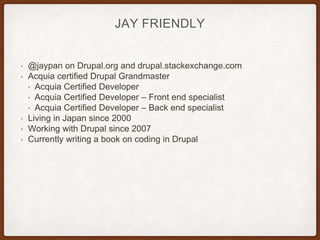
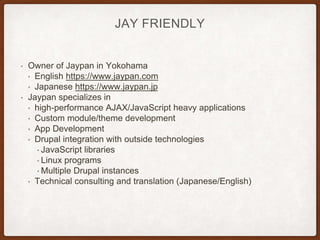
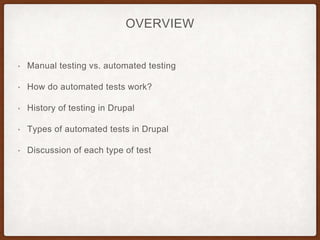

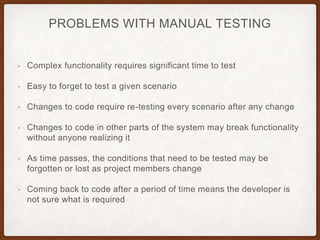
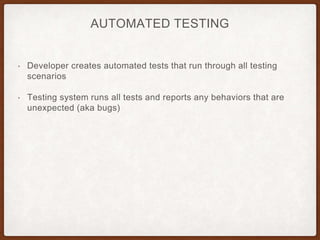

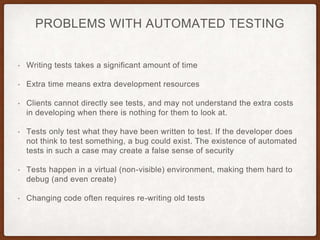

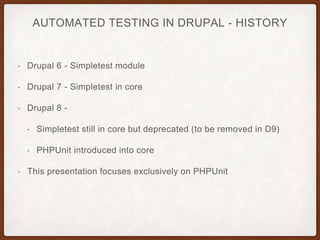
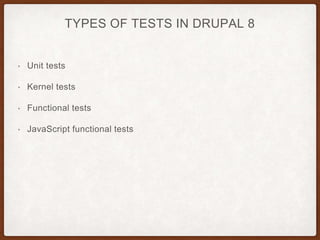

![UNIT TEST OVERVIEW
• Unit tests go in [MODULENAME]/tests/src/Unit
• Namespace is DrupalTests[MODULENAME]Unit
• Unit tests extend DrupalTestsUnitTestCase
• Annotation should include (at a minimum)
• Class:
• @coversDefaultClass - the class the the test is testing
• @group - the group of tests (usually module name) that the test belongs to
• Method:
• @covers - the method of the class being tested](https://image.slidesharecdn.com/automatedphpunittestingindrupal8-170128045400/85/Automated-php-unit-testing-in-drupal-8-14-320.jpg)
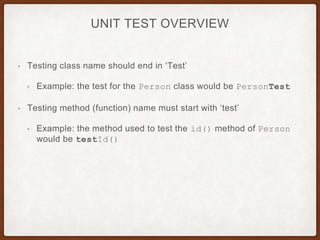
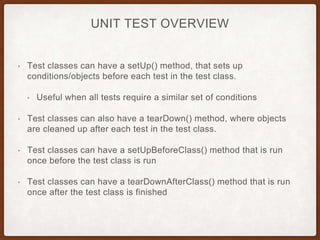
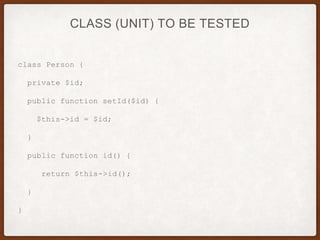


![KERNEL TEST OVERVIEW
• Kernel tests go in [MODULENAME]/tests/src/Kernel
• Namespace is DrupalTests[MODULENAME]Kernel
• Kernel tests extend DrupalTestsKernelTestBast](https://image.slidesharecdn.com/automatedphpunittestingindrupal8-170128045400/85/Automated-php-unit-testing-in-drupal-8-20-320.jpg)

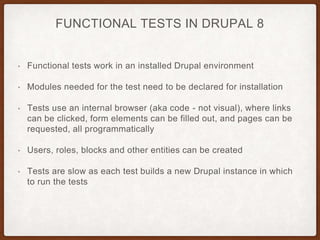
![FUNCTIONAL TEST OVERVIEW
• Unit tests go in [MODULENAME]/tests/src/Functional
• Namespace is DrupalTests[MODULENAME]Functional
• Unit tests extend DrupalTestsBrowserTestBase
• Annotation should include (at a minimum)
• Class:
• @group - the group of tests (usually module name) that the test belongs to
• $modules property contains an array of modules to be installed
• example: $modules = [‘node’, ‘restrict_ip’]](https://image.slidesharecdn.com/automatedphpunittestingindrupal8-170128045400/85/Automated-php-unit-testing-in-drupal-8-23-320.jpg)
![FROM RESTRICT IP MODULE
EXAMPLE FUNCTIONAL TEST
namespace DrupalTestsrestrict_ipFunctional;
/**
* @group restrict_ip
*/
class RestrictIpAccessTest extends RestrictIpBrowserTestBase // which extends BrowserTestBase
{
protected static $modules = ['restrict_ip', 'node'];
/**
* Test that a user is blocked when the module is enabled
*/
public function testModuleEnabled()
{
$adminUser = $this->drupalCreateUser(['administer restricted ip addresses', 'access administration
pages', 'administer modules']);
$this->drupalLogin($adminUser);
$this->drupalGet('admin/config/people/restrict_ip');
$this->assertStatusCodeEquals(200);
$this->checkCheckbox('#edit-enable');
$this->click('#edit-submit');
$this->assertSession()->pageTextContains('The page you are trying to access cannot be accessed from
your IP address.');
}
}](https://image.slidesharecdn.com/automatedphpunittestingindrupal8-170128045400/85/Automated-php-unit-testing-in-drupal-8-24-320.jpg)
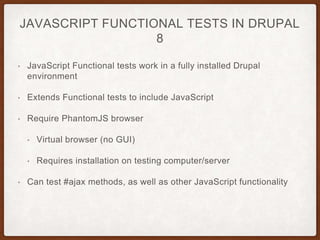
![JAVASCRIPT FUNCTIONAL TEST OVERVIEW
• Unit tests go in [MODULENAME]/tests/src/FunctionalJavascript
• Namespace is
DrupalTests[MODULENAME]FunctionalJavascript
• Unit tests extend
DrupalFunctionalJavascriptTestsJavascriptTestBase
• Annotation should include (at a minimum)
• Class:
• @group - the group of tests (usually module name) that the test
belongs to](https://image.slidesharecdn.com/automatedphpunittestingindrupal8-170128045400/85/Automated-php-unit-testing-in-drupal-8-26-320.jpg)
